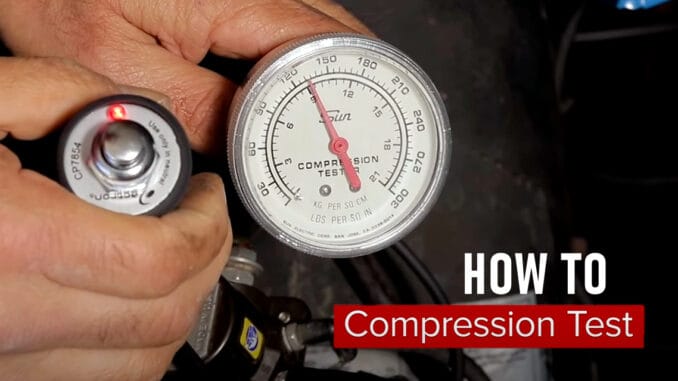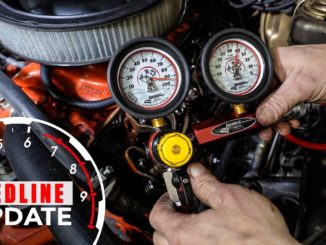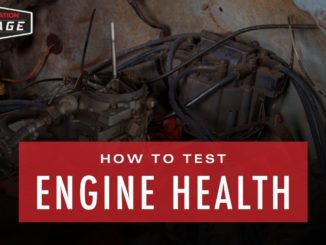
Compression testing measures the condition of an engine’s cylinders, rings, and valves.
Before you start, find a helper. While a compression test can be performed alone, it is more difficult and you can’t see how the cylinders pump up.
Dry Compression Test
The engine must be warm, the ignition disabled, and all sparkplugs removed.
Caution: Wear protective clothing and gloves while working around a hot engine.
While performing the test, the throttle and choke plates must be fully open for an accurate test.
Have your helper fully depress the accelerator while cranking the engine.
Caution: Avoid any flames around the engine during the test because of the air/fuel mixture being pumped out of the open sparkplug holes.
Connect the compression tester to a cylinder and turn the engine over about 6 to 8 compression strokes. You will be able to hear the cranking speed slow as the tested cylinder comes up on its compression stroke. Note how fast the compression increases and record the highest reading.
Test all cylinders the same way with the same number of compression strokes.
Interpreting the Readings
There is more than one school of thought on what the compression of the average engine should be.
As a general rule, a compression reading of 135 PSI or better is good, and a compression of 85 PSI or lower is bad.
The most desirable situation is that all cylinders give the same or close to the same reading, and that reading is above 135 PSI.
Uneven readings are not uncommon on worn engines, and as long as the difference between the highest and lowest readings are no more than 21 PSI and the lowest reading is 100 PSI or better, then the engine is acceptable. Greater differences between cylinders indicate worn or broken rings, leaky or sticky valves, or a combination of all.
When you were observing the gauge during the cranking of the engine, you should have noticed the way each cylinder pumped up. Usually, a cylinder will produce about 40 PSI on the first stroke and about 35 PSI on each additional stroke until the maximum compression is reached.
Problem cylinders may have trouble pumping up and may increase by only something like 10 PSI per stroke. You may be able to crank these cylinders enough times to come close to the other cylinder’s total PSI, and this is one reason to limit the number of compression strokes.
Poor rings usually cause this condition. Be aware that a cylinder suffering from excessive oiling, even from bad rings, can yield high compression test results because the excess oil in the cylinder seals the rings. Other symptoms may give you a clue to the problem (a smoking engine).
There are some variables that affect the readings obtained from compression testing, including:
- cranking speed,
- altitude,
- temperature,
- worn camshaft lobes, and
- high-performance long-duration profile camshafts.
The cranking speed needs to be maintained the same for each cylinder. This may mean jumping your battery to maintain the speed. The effect of the two camshafts above is the same, one of lower readings. Compression data is usually based on 14.7 atmospheric pressure and 59F at sea level. There are factors to compensate for the different altitudes and the corresponding temperature differences. These are as follows:
1000′ = .9711
2000′ = .9428
3000′ = .9151
4000′ = .8881
5000′ = .8617
6000′ = .8359
7000′ = .8106
8000′ = .7860
The equivalent compression reading for a cylinder that should be 135 PSI by the data at 5000′ would be 135 x .8617 = 116.33.
Wet Compression Test
Many automotive books describe a dry and a wet compression test. Usually, these tests must be interpreted together to isolate the trouble in cylinders or valves. Unfortunately, the wet compression test is unreliable when performed on engines where the cylinders are horizontal (like the old VW).
To perform the wet test, a tablespoon of oil is poured into the cylinder through the sparkplug hole before checking the compression. On horizontal cylinders, oil does not spread evenly over the piston crown, a necessity for this test.
With the above said, you squirt the tablespoon of oil (SAE 30W is fine) into a cylinder that is reading low. Crank the engine two revolutions or so to spread the oil then retest the cylinder. If the compression comes up markedly, 40 PSI or more, the trouble is poor ring-to-bore sealing. If compression doesn’t increase much, about 5 PSI, then the problem is probably with the valves. It could also be pulled head studs or a warped cylinder head.
RECAP:
- Charge the battery if the battery is not fully charged.
- Disable the ignition system.
- Disable the fuel injection system.
- Remove all of the spark plugs.
- Block the throttle plate wide open.
- Start with the compression gauge at zero, and crank the engine through 6 compression strokes (6 puffs).
- Make the compression check for each cylinder. Record the reading.
If a cylinder has low compression, inject approximately 15 ml (one tablespoon) of engine oil into the combustion chamber through the spark plug hole, recheck the compression and record the reading.
The minimum in any one cylinder should not be less than 70% of the highest cylinder. No cylinder should read less than 100 PSI. For example, if the highest pressure in any one cylinder is 150 PSI, the lowest allowable pressure for any other cylinder would be 105 PSI.
Interpreting the Readings
Normal: Compression builds up quickly and evenly to the specified compression for each cylinder.
Piston Rings Leaking: Compression is low on the first stroke. Compression builds up with the following strokes but does not reach normal. Compression improves considerably when you add oil.
Valves Leaking: Compression is low on the first stroke. Compression usually does not build upon the following strokes. Compression does not improve much when you ad oil.
If two adjacent cylinders have lower than normal compression and injecting oil into the cylinders does not increase the compression, the cause may be the head gasket leaking between the cylinders.








